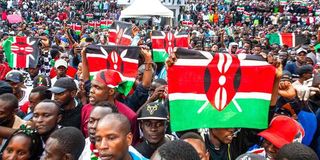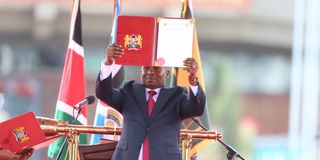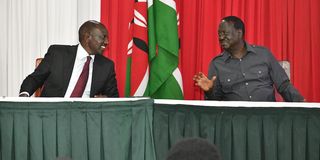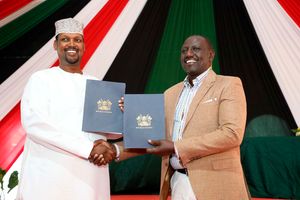
Two vehicles torched amid protests on June 12th 2025 along Nkrumah Lane in Nairobi.
In the run-up to the 2022 election, President William Ruto cobbled together a political behemoth of 12 parties that ultimately swept him to power.
But the unprecedented nationwide Gen Z protests, barely two years into his term, have threatened the alliance’s existence, triggering major political fallouts including a rift between the President and then Deputy President Rigathi Gachagua.
Although there is no direct link between the protests and the fallout, the President’s move to form a broad-based government by teaming up with veteran politician Raila Odinga in response to the uprising secured him the required numbers in Parliament for potential impeachment proceedings.

Participants during the Shujaaz Memorial concert held on July 7, 2024 at Uhuru Park in Nairobi.
At the same time, some founding members of the Kenya Kwanza alliance were kicked out of the Cabinet in the wake of the protests, while others have since exited amid escalating political tensions.
Leading up to the polls, a total of 12 parties convened at the Ngong Racecourse in Nairobi to formally launch the Kenya Kwanza alliance on April 12, 2022.
The signing of the political pact was followed by months of intense joint presidential campaigns that saw then Deputy President Ruto stage a successful battle against his boss President Uhuru Kenyatta, who backed Mr Odinga for the top seat.
Deep state
The parties that signed the pact included President Ruto’s United Democratic Alliance (UDA), the now-defunct Amani National Congress of Musalia Mudavadi, National Assembly Speaker Moses Wetang’ula's Ford Kenya, Justin Muturi's Democratic Party (DP), Moses Kuria's Chama Cha Kazi and the Communist Party of Kenya.
Others included Mwangi Kiunjuri's The Service Party (TSP), William Kabogo's Tujibebe Party, the Farmers Party of former Principal Secretary Irungu Nyakera, the Devolution Party of Kenya, the Economic Freedom Party (EFP) of Isaac Abey, and Martin Wambora's Umoja na Maendeleo Party.
Midway through the campaigns, the Pamoja African Alliance (PAA) associated with Senate Speaker Amason Kingi and the Maendeleo Chap Chap Party (MCCP) led by Labour Cabinet Secretary Alfred Mutua defected from Mr Odinga’s Azimio La Umoja One Kenya Coalition to join Dr Ruto’s team.
With backing from these parties, Dr Ruto swept to power in the August 8, 2022 election as an outsider—albeit one in government—defeating the so-called "deep state."
His victory subsequently attracted even more parties previously aligned with Mr Odinga including the United Democratic Movement (UDM) of Mandera Senator Ali Roba, the Movement for Democracy and Growth (MDG) of Ugenya MP David Ochieng’ and the National Ordinary People Empowerment Union (NOPEU) of Tigania East MP Mpuru Aburi.
But the real turmoil began in June 2024 when a routine budget process ignited a national revolt.
The proposed Finance Bill, 2024 laden with new taxes amid a punishing cost-of-living crisis enraged Kenya’s youth who flooded the streets in a Gen Z-led uprising.
Parliament became a battleground as Speaker Wetang’ula was forced to flee through an underground tunnel as protesters demanded accountability.
The government buckled. The Bill was withdrawn and President Ruto sacked nearly the entire Cabinet. Casualties included Njuguna Ndung’u (National Treasury and Economic Planning), Ababu Namwamba (Youth Affairs, Creative Economy and Sports), Florence Bore (Labour and Social Protection), Simon Chelugui (Co-operatives and MSME Development), Moses Kuria (Public Service), Aisha Jumwa (Gender, Culture, Arts and Heritage), and Susan Nakhumicha (Health).
Other key figures removed were Ezekiel Machogu (Education), Mithika Linturi (Agriculture), Eliud Owalo (ICT), Peninah Malonza (EAC and ASALs) and Zacharia Njeru of Water.
By October 2024, Mr Rigathi Gachagua, a self-proclaimed gatekeeper of Dr Ruto’s administration, was impeached on charges of corruption and divisiveness.

Prof Kithure Kindiki after his swearing-in as Kenya's Deputy President on November 1, 2024.
His fall cleared the way for Prof Kithure Kindiki’s rise.
At the party level, Mr Gachagua was ousted as UDA deputy party leader and his ally Cleophas Malala was also removed as party secretary-general. The two, alongside Mr Linturi, have since founded a new outfit the Democracy for the Citizens Party (DCP).
“We will inevitably see more political realignments. The Gen Z protests epitomised the broad public disaffection with the Kenya Kwanza regime. Ultimately, 2027 could mirror 1992 if the opposition is divided, or resemble 2002 if it unites,” said Prof David Monda, a US-based political analyst.
“Either way, I foresee mass defections from Kenya Kwanza. But one cannot rule out Ruto—he will use state resources, patronage, and coercion to attract opposition members or plant moles to keep them divided,” he added.

Former Attorney General Justin Muturi.
Mr Justin Muturi who initially survived the Cabinet purge by being reassigned from Attorney General to Public Service CS, later fell out with the President following what he termed state-sponsored abductions. He was dismissed in March 2025.
In an interview with the Nation, Mr Muturi said he regretted joining Kenya Kwanza calling Ruto “an unmitigated disaster on many fronts.”
Support Ruto
“Although I was reluctant to join the alliance, there was strong grassroots pressure to support Ruto due to the ‘kumi yangu, kumi ya Ruto’ promise. Dr Ruto has been a disaster, especially in terms of economic mismanagement and undermining the independence of government institutions,” said Mr Muturi.
The Farmers Party led by Mr Nyakera has since formally exited the alliance. DP, associated with Mr. Muturi, is also in the process of leaving.
Mr Nyakera who was dismissed as chair of the Kenyatta International Convention Centre in April said he joined Kenya Kwanza in good faith, believing in its bottom-up economic model.
“Our aim was to contribute to a government that upheld constitutionalism, inclusivity and economic empowerment. But what we have seen is dishonesty, political infidelity and disregard for the Constitution,” he told the Nation.
He said the turning point came when UDA began pushing affiliate parties to dissolve and merge, a move he said contradicted the spirit of inclusivity.
The biggest surprise came on March 7, 2025, when President Ruto and Mr Odinga signed a cooperation agreement ushering opposition allies into government and dramatically reshaping Kenya’s political landscape.

President Willam Ruto and ODM party leader Raila Odinga during the MoU signing event at KICC on March 7, 2025.
The pact was formalised even as some ODM figures had already taken Cabinet positions.
“The breaking point was when major decisions, like the ODM pact, were made unilaterally by UDA without consultation. Repeated broken promises and lack of inclusivity destroyed the coalition,” Nyakera said.
But Nandi Senator Samson Cherargei, a close Ruto ally, defended the move as a strategic realignment ahead of 2027.
“We want to build a broader coalition. Cooperation with national parties like ODM is part of promoting unity. Going forward, we will emerge stronger with more partners. Our other affiliates remain united,” Mr Cherargei said.






